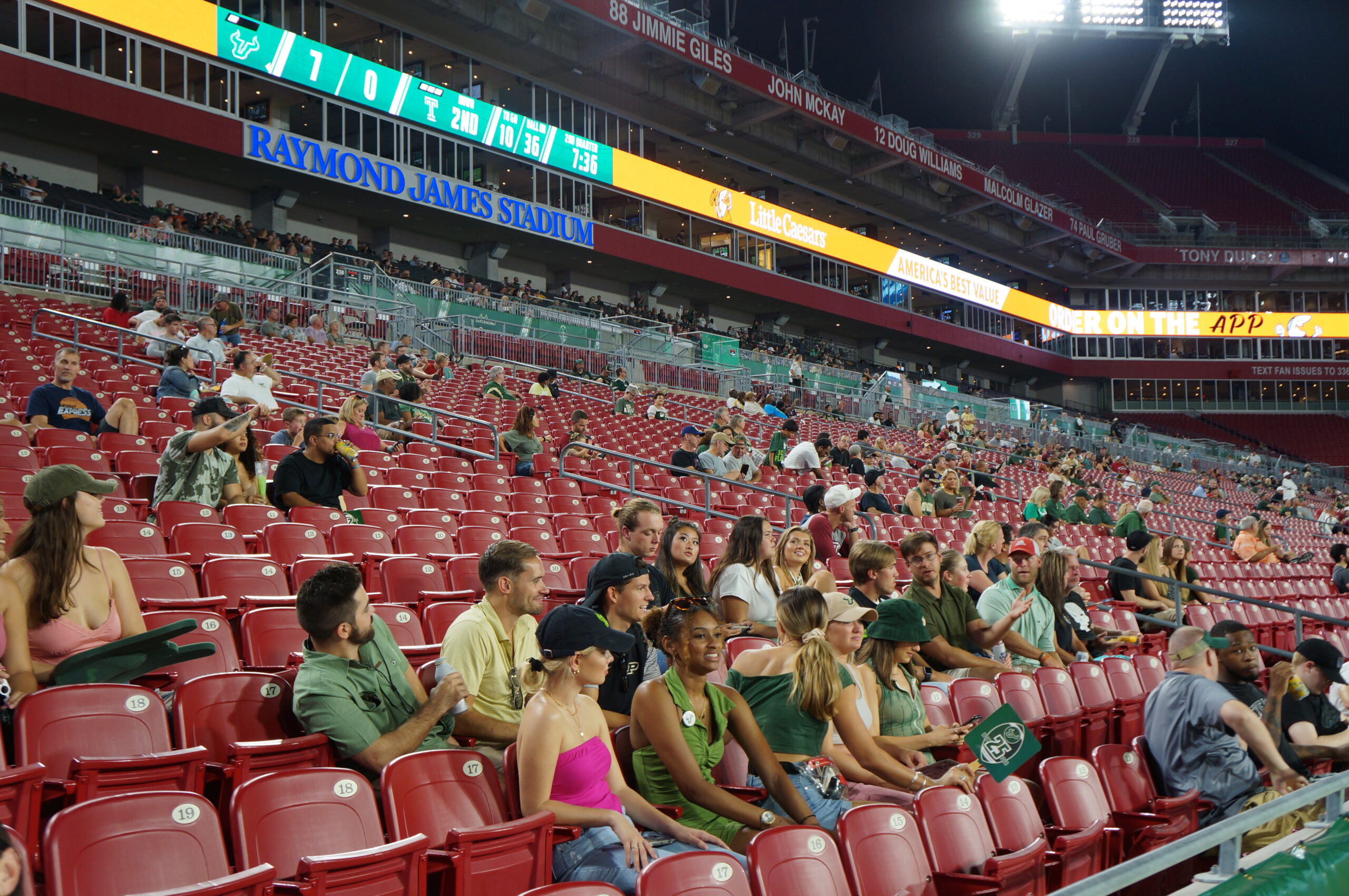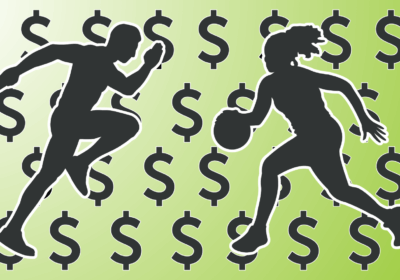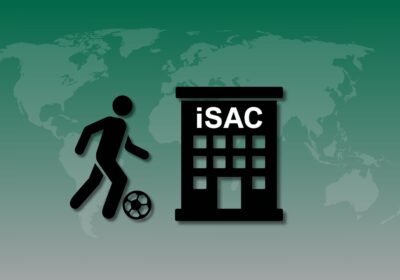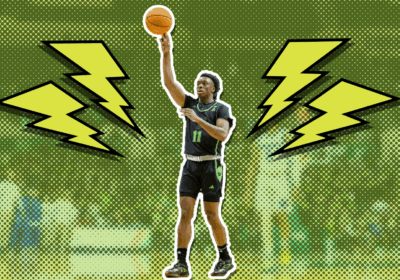Athletics department, fans cite losing, lack of on-campus stadium among reasons for poor attendance

It’s no secret fan attendance at home football games has become an issue for USF in recent years. Long gone are the days of filling Raymond James Stadium on a Saturday night with thousands of rowdy supporters gearing up to rally behind the Bulls.
From administration to fans, everyone has their beliefs as to what the main catalysts are behind the low fan attendance, but a recent trend of losing is a good place to start, according to Associate Athletic Director for External Relations Meredith Scerba.
Twenty-five seasons, five head coaches, three conferences, two subdivisions and a 160-137 overall record since its inception in 1997 is the history of USF football in a nutshell.
There have been highs — such as a No. 2 BCS ranking in 2007 — and there have been lows, but perhaps never as low as the three-year stretch the Bulls currently find themselves in.
USF is 7-32 since winning seven straight games to open the 2018 season, a winning percentage of just under 18%. The only comparable time in Bulls history with such struggle is a run from 2012-14, the last year under Skip Holtz and the first two years of the Willie Taggart era, when the team had a 9-27 record.
“It starts with winning, obviously, everyone wants to come out [when you’re winning],” Scerba said. “But at the end of the day, we’re looking at ways to make it just a fun experience. Like, what can make this something that they wouldn’t want to miss, win or lose? That’s our job and that’s what we’re working to do.”
Apart from the 2020 season, a year in which attendance numbers dipped heavily due to the pandemic, the Bulls have averaged approximately 21,512 fans per home game in Raymond James Stadium in the 2019 and 2021 seasons combined, according to turnstile counts provided by Associate Athletics Director Brian Siegrist.
Removing the outlier that is the Sept. 11 Florida game, a contest that pulled in over 54,000 fans, the average dips to approximately 18,185 fans per game. Raymond James Stadium can hold between 65,000-75,000 people, and USF, on average, has hardly been able to fill even a third of that in recent years.
The issue may not even be as simple as just winning, though. The Bulls played seven home games in 2016, a season in which former quarterback Quinton Flowers led them to an 11-2 record and a Birmingham Bowl victory, and in those games the average number of fans in the seats was 25,596.
Just like when removing the Florida game from 2021, however, the outlier in this season significantly shifts the numbers. USF hosted Florida State in 2016 and 48,724 fans were in attendance. By removing that game, the average attendance for the other six contests was 19,586, marginally higher than the 2019 and 2021 combined average.
If losing is not the driving force for the low attendance, another major talking point is the prospect of an on-campus stadium.
A football venue being constructed on the Tampa campus has been discussed for years, but an impassioned promise from Board of Trustees Chair Will Weatherford on Sept. 8 sent the conversation into overdrive.
“I think [an on-campus stadium] is going to 100% help us … There’s just a cool vibe about it being our own. From a game experience perspective, it feels like ours, it’s our home,” Scerba said.
“It’s not looking like Christmas with [the] red [of the Buccaneers] and green [of USF in Raymond James Stadium]. It’s all green. And we have a little bit more flexibility with the things that we can do in regard to our branding and our look and our feel.”
USF alum Santiago Correa said an on-campus stadium would be a positive for athletics, as he believes it would lead to consistent fandom.
“I think an [on-campus stadium] would rally and intrinsically foster school spirit to become multigenerational,” he said.
For sophomore Alisha Kurian, the venture would allow for easier access to games, leading to more students showing up who may not have before and eventually getting hooked.
“I think having an on-campus stadium caters more to the student who maybe [is] not really a huge football fan, they don’t really care about it, but if it’s there they’ll go to a game,” Kurian said. “I think that’s how you create more lifelong fans.
“[Maybe] you don’t really go to games, but then you start going because the stadium is right there, and what do you know, four years later you keep coming back. I think that’s the goal.”
Despite the optimism from Scerba, Correa and Kurian, there has yet to be an official update regarding an on-campus stadium from the university since Weatherford’s Sept. 8 remarks.
Another potential issue in drawing fans to games is the fact that USF is competing in a market with no shortage of amateur and professional sports teams, and good ones at that. From the Lightning, who won back-to-back Stanley Cups in 2020 and 2021, to the reigning Super Bowl champion Buccaneers, fans have a number of franchises to choose to support.
“For me personally, [I don’t do this], but I do see [people picking other games to attend over USF’s] quite often unfortunately,” Correa said. “Because the folks that want to go and be entertained are not getting entertained [by USF]. The opportunity cost is falling to not attend.
“I guess what’s challenging when you’re not doing well and you’re not entertained, the excuse for not going [to games] becomes less burdensome.”
Scerba said USF has to deal with obstacles in Tampa which other institutions in more traditional college towns may not have to.
“We’re in an interesting situation in Tampa, where students have a lot of options,” Scerba said. “They have a lot more options than they would in a college town like Gainesville or somewhere else. So we’re always up against a lot of obstacles and challenges [and] of people trying to make decisions on what things that they want to do on the weekends.”
In an effort to combat the attendance woes, the university has deployed a number of incentives to encourage fan engagement, such as the Herd Perks program.
The sweepstakes is a contest sponsored by the athletics department, among others, that encourages students to go to games by awarding them points for attending. Those with the most points at the end of the athletics season have a chance to win a prize, namely a 2021 Ford Mustang.
Although Herd Perks does its job in creating an incentive to go to games and claim points, there is still a disconnect between athletics and the average student, according to Kurian.
“I like [Herd Perks], I think it’s a good initiative, but I have to admit, I only go on Herd Perks if I’m looking to get a ticket for a game that I’m planning on going to or if I’m at the game itself and I’m just trying to get points,” Kurian said.
“It’s not something that you check daily or something like that. I see [when] games [are] because I follow a lot of USF Athletics pages, but for the average student who maybe doesn’t follow athletics that closely, I don’t think they really incorporate Herd Perks into a routine.”
Scerba said her team is constantly working to come up with new ideas to attract more interest to the athletics department as a whole, and has even spoken to current students to gauge how much of a difference their initiatives are making, as well as to listen to suggestions they may have to further engage fans.
“It was good to get [student] feedback, because I need to know if that stuff that I’m doing is not impactful enough, and it’s clearly not leaving a lasting memory for [someone] to post that they don’t see anything [about athletics],” Scerba said.
With a potential on-campus stadium on the horizon and other infrastructure also being built, Scerba said she hopes both the current student body and alumni continue to support athletics, because together they make up the fan base and are the lifeblood of the collegiate sport expereince.
“[The students] really influence the game itself,” Scerba said. “They start the wave, they’re the ones that start the cheers, they’re the ones painting their bodies, and our alum that look over there, it fills them [with spirit] as well. They both feed off of each other … that is why people come around to be around college sports.”







